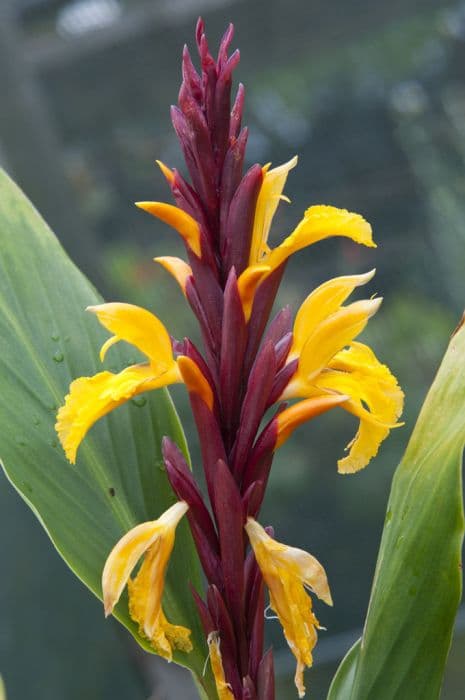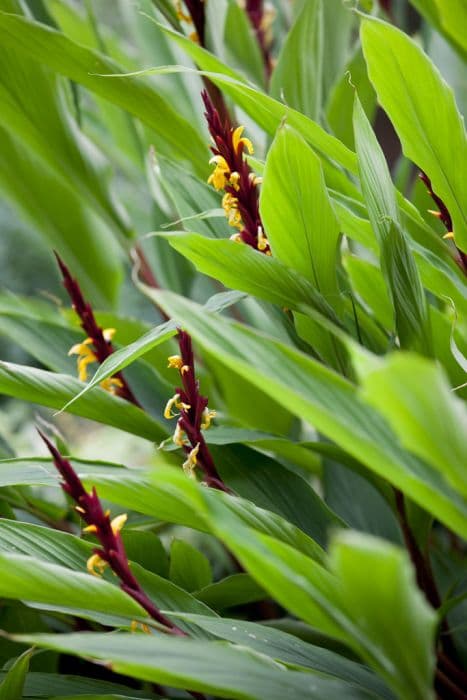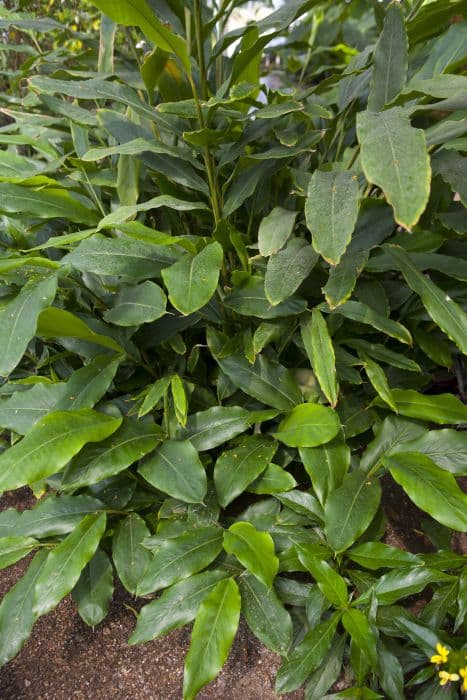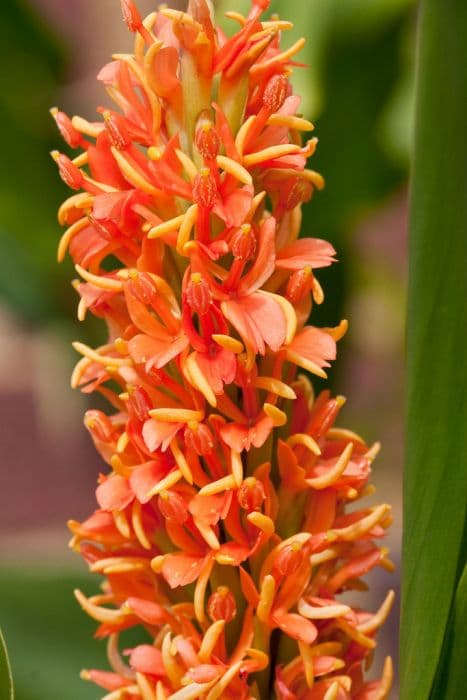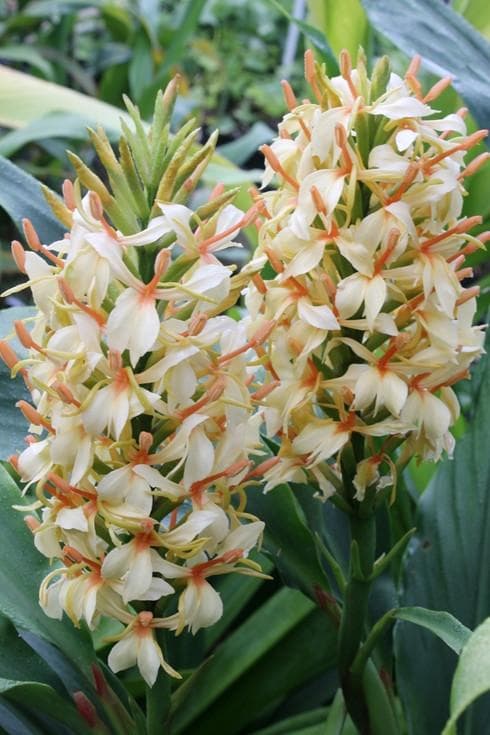Japanese ginger Zingiber mioga 'Crûg's Zing'

ABOUT
Zingiber mioga 'Crûg's Zing', also known as Japanese ginger, is a plant that boasts a lush and tropical appearance, often characterized by its striking green foliage. The leaves are typically elongated and have a smooth texture, with a glossy finish that highlights their vibrancy. Japanese ginger is also known for its unique floral display. The flower buds emerge in an intriguing cone-like shape, gradually unfurling to reveal delicate, intricate flowers. The blossoms themselves tend to be quite subtle in color, often presenting in creamy white tones with subtle hints of yellow or pink. These flowers usually bloom close to the ground and can sometimes be partially hidden by the surrounding leaves, giving them an elusive charm. Additionally, the plant's underground parts are of culinary and ornamental interest, though they are seldom seen above the soil. All in all, Japanese ginger presents an elegant and exotic aesthetic, contributing a touch of the tropics to the spaces it inhabits.
About this plant
 Names
NamesFamily
Zingiberaceae
Synonyms
Japanese Ginger, Myoga Ginger, Myoga
Common names
Zingiber mioga.
 Toxicity
ToxicityTo humans
The Japanese Ginger is not toxic to humans. In fact, parts of this plant are edible and used in cooking.
To pets
The Japanese Ginger is not known to be toxic to pets such as cats and dogs. Parts of the plant are edible for human consumption and there is no widespread evidence of toxicity in common household pets from this plant. However, it is always advisable to prevent pets from eating plants as individual animals may have sensitivities or allergic reactions.
 Characteristics
CharacteristicsLife cycle
Perennials
Foliage type
Deciduous
Color of leaves
Green
Flower color
Yellow
Height
2 feet (0.61 meters)
Spread
2 feet (0.61 meters)
Plant type
Herb
Hardiness zones
7
Native area
Asia
Benefits
 General Benefits
General Benefits- Ornamental Appeal: Zingiber mioga 'Crûg's Zing', commonly known as mioga or Japanese ginger, adds exotic beauty to gardens with its lush foliage and unique flowers.
- Culinary Uses: The flower buds and young shoots of mioga are edible and commonly used in Japanese cuisine, providing a mild ginger flavor to dishes.
- Shade Tolerance: Mioga is suitable for shaded areas of the garden, where other sun-loving plants may not thrive.
- Drought Resistance: Once established, mioga can be relatively drought-tolerant, requiring minimal watering during dry periods.
- Low Maintenance: Mioga requires little care once it's established, making it suitable for gardeners of all levels.
- Pest Resistance: The plant is generally resistant to pests, reducing the need for chemical treatments.
- Perennial Growth: As a perennial, mioga comes back year after year, making it a long-term addition to the garden.
 Medical Properties
Medical Properties- Anti-inflammatory effects: The rhizome of Zingiber mioga has been traditionally used to reduce inflammation.
- Antioxidant properties: The plant may contain compounds that help to protect cells from oxidative damage.
- Digestive aid: Zingiber mioga is sometimes used in traditional medicine to support digestion.
- Relief from nausea: Similar to its close relative, ginger, it may help in alleviating symptoms of nausea and vomiting.
- Antimicrobial activity: Extracts from the plant have shown potential in fighting against certain bacteria and fungi.
 Air-purifying Qualities
Air-purifying QualitiesThis plant is not specifically known for air purifying qualities.
 Other Uses
Other Uses- Japanese ginger 'Crûg's Zing' can be used to create natural dyes for fabrics, offering subtle colors that are environmentally friendly.
- In some cultures, the decorative flowers are used in art and craft projects, like pressing them for scrapbooking or embellishing handmade paper.
- This plant's aromatic leaves can be incorporated into potpourris or sachets to add a spicy fragrance to drawers and closets.
- Landscape designers often use Japanese ginger 'Crûg's Zing' for its ornamental value in shaded garden areas where few other plants thrive.
- In culinary presentations, its colorful flowers serve as an edible garnish for delicate desserts or as a decorative element in sushi platters.
- It's used in companion planting to help deter pests naturally in vegetable gardens, taking advantage of its aromatic properties.
- Hobbyists might use the fibrous stems to create small, eco-friendly artifacts, such as mats or baskets, through weaving techniques.
- The plant's root structures can help in soil erosion control, making it a practical choice for planting on slopes or in areas prone to erosion.
- Photographers and artists might use Japanese ginger 'Crûg's Zing' as a subject or background due to its unique aesthetic appeal.
- It can be planted in containers and placed on balconies or patios to create a lush, tropical feel in urban environments.
Interesting Facts
 Feng Shui
Feng ShuiThe plant Japanese ginger is not used in Feng Shui practice.
 Zodiac Sign Compitability
Zodiac Sign CompitabilityThe plant Japanese ginger is not used in astrology practice.
 Plant Symbolism
Plant Symbolism- Resilience: The Zingiber mioga, commonly known as Japanese Ginger, is a hardy plant that can continue to grow under various conditions, symbolizing the ability to endure and adapt.
- Prosperity: In some cultures, gingers are linked to attracting wealth and success, hence this variety might also carry such symbolism.
- Health: Gingers are widely recognized for their medicinal properties, so the Zingiber mioga might symbolize good health and vitality.
- Exotic Beauty: With its unique foliage and flowers, the Japanese Ginger can symbolize exotic beauty and the allure of the unfamiliar.
- Culinary Enjoyment: Given its use in cuisine, Zingiber mioga represents the pleasures of the table and the enjoyment of flavors.
 Water
WaterJapanese ginger requires consistent moisture but dislikes waterlogged soil. Water it once a week with approximately 1 inch of water, ensuring the topsoil is moist but not saturated. Increase watering to twice a week during periods of high heat or drought. In cooler, wetter conditions, reduce the frequency to prevent root rot. It's best to water in the morning to allow leaves to dry out during the day, reducing the risk of fungal diseases. Over the course of a month, this would typically amount to 4-8 gallons, depending on the weather and soil conditions.
 Light
LightJapanese ginger thrives in partial shade, making it well-suited for a spot that receives dappled sunlight throughout the day. It can tolerate morning sun but should be protected from the intense afternoon rays, which can scorch its foliage. A north-facing garden or an east-facing position where it can receive the gentler morning light provides the ideal lighting conditions for this plant.
 Temperature
TemperatureJapanese ginger prefers a temperature range between 60°F and 75°F for optimal growth. It can tolerate a minimum temperature of around 15°F, as it is quite cold-hardy for a ginger plant. Extreme temperatures above 90°F can stress the plant, so providing some shade during the hottest part of the day is beneficial.
 Pruning
PruningPruning of Japanese ginger is mainly for aesthetic purposes and to remove any spent flowers or dead foliage. The best time to prune is in late winter or early spring before new growth begins. Pruning just once a year is typically sufficient, cutting back any old stems to the ground to encourage fresh, healthy shoots.
 Cleaning
CleaningAs needed
 Soil
SoilJapanese ginger (Zingiber mioga 'Crûg's Zing') thrives in a soil mix that is well-draining, rich in organic matter, and slightly acidic to neutral with a pH of 5.5 to 7.0. A mix of garden soil, compost, and perlite or pumice will create an ideal growing environment.
 Repotting
RepottingJapanese ginger should be repotted every 2-3 years or when it becomes root-bound. Use a slightly larger pot with appropriate soil mix to allow for new growth.
 Humidity & Misting
Humidity & MistingJapanese ginger prefers high humidity levels, ideally between 60-80%. It will benefit from regular misting or a humidifier if grown indoors to maintain these humidity conditions.
 Suitable locations
Suitable locationsIndoor
Place Japanese ginger in bright, indirect light and ensure high humidity.
Outdoor
Plant in partial shade and moist, rich soil.
Hardiness zone
7-10 USDA
 Life cycle
Life cycleThe Zingiber mioga 'Crûg's Zing', more commonly known as Japanese Ginger or Myoga, begins its life as a rhizome, which sprouts in the spring to produce leafy stems and foliage. During the growing season, the plant’s leaves reach maturity and may produce small, ornamental flowers near the ground, which are often overshadowed by the foliage. As the summer progresses, the flowers give way to small, edible flower buds that are prized in Japanese cuisine. In autumn, the above-ground foliage dies back as the plant enters dormancy to conserve energy over the winter. Throughout the dormant period, the rhizome survives underground and can withstand cold temperatures. Come the following spring, the cycle repeats as new growth emerges from the rhizome, continuing the perennial life cycle of the plant.
 Propogation
PropogationPropogation time
Spring to Summer
Propogation: The Zingiber mioga 'Crûg's Zing', commonly known as Japanese ginger, is typically propagated by division, which is the process of separating the rhizomes to create new plants. The best time for propagating Japanese ginger by division is in the spring, just as new growth begins. This allows the plants ample time to become established before the colder months. To propagate by division, you would carefully unearth the plant, preserving as much of the root system as possible, and identify the rhizome sections that have at least one or two growth buds. These rhizomes can then be cut using a clean, sharp knife into sections, ensuring each piece includes a growth bud. Afterward, the divided sections are planted in moist, well-draining soil, at a depth of about 2 to 3 inches (5 to 7.6 centimeters), spaced around 12 inches (30 centimeters) apart to allow room for growth. The new divisions will typically take a few weeks to establish and start producing new shoots.
